If you’re thinking of growing a tree in your garden, Aussie natives should be at the top of your list!
Native plants are best suited to your local climate and environment. They’ve adapted to grow in native soils, and many are drought-tolerant, so they need less watering.
These trees also play a key role in local ecosystems! Many provide food and shelter for wildlife, with some animals found only around certain species.
With such immense diversity in native trees, we couldn’t possibly name them all. But we’ve rounded up our favourite Australian native trees for all your garden needs — shade, flowers, and more.
Australian Native Trees List
NOTE: Certain species of trees may be considered invasive or environmental weeds outside their native ranges. These include:
- Brush box
- Eucalypts (mainly Sugar gum)
- Grevilleas
- Hakeas
- Tuckeroo
- Wattles
- Willow Myrtle Agonis flexuosa
Check local state or council regulations for any restrictions on native tree species you can plant in your area.
Australian Native Evergreen Trees
Evergreen trees are exactly what their name says — the leaves remain on the tree, no matter the season!
They make excellent feature trees since they retain their foliage year-round.
Black She-oak
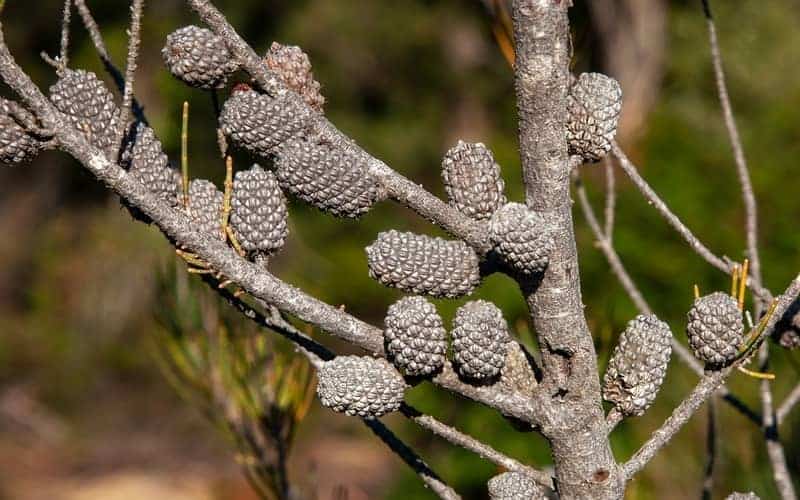
Size: Up to 15m
Native range: Eastern coast, from QLD to TAS
Conditions: Most climates, well-draining soil, full sun to light shade
There’s plenty to love about the Black She-oak (Allocasuarina littoralis) — it tolerates a wide range of climates, does well in most soils, and is fast-growing! The roots also return nitrogen to the soil as a natural fertiliser.
You’ll recognise this Allocasuarina by the dark green, soft needles and textured cones (sometimes known as Caspers).
In spring, Black She-oak trees have small but pretty red flowers. The male trees don’t bear fruit but are needed for pollination.
A. littoralis trees do not do well in sandy or soggy soils, and grow better in a sunny spot. They can tolerate cold down to -5ºC, though saplings need shelter from frost.
NOTE: Black She-oak has a large, invasive root system, so plant it away from sewage systems and structures.
Blueberry ash

Size: Up to 15m
Native range: Eastern coast (QLD to TAS) and parts of VIC
Conditions: Subtropical and warm temperate, well-draining soil, full sun to partial shade
Despite the name, Blueberry ash (Elaeocarpus reticulatus) doesn’t produce fruits that taste good for people. Your local birds will appreciate the year-round fruit, though!
Blueberry Ash trees feature stunning, frilly pink or white flowers, which appear from spring to early summer. The leaves are bronzy-pink when new, then deepen to green as the leaf matures.
A. reticulatus is fairly low-maintenance. It thrives best when well-watered. but doesn’t do well in cold climates or soggy soils.
The narrow form and dense foliage make Blueberry Ash the perfect tree for privacy or screening.
Finger lime
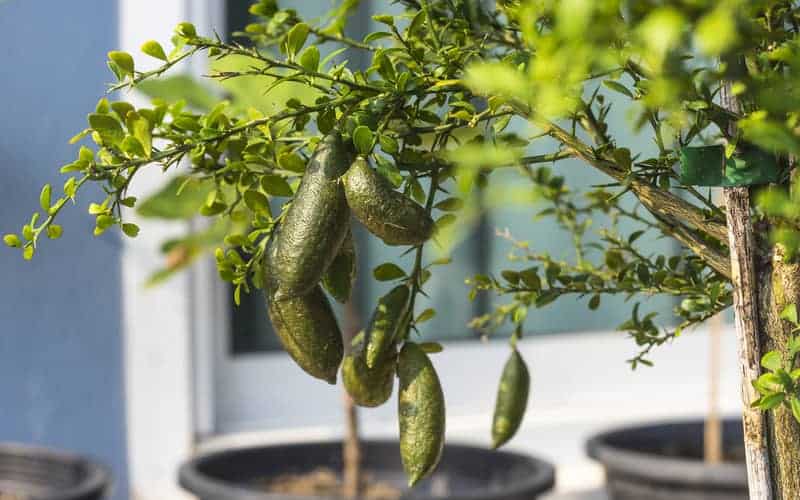
Size: Up to 6m
Native range: Southeast QLD to northern NSW
Conditions: Subtropical climates, well-draining soil, full sun to dappled shade
Native finger limes (Citrus australasica) are pretty prickly — this tree has a thorny habit. But the delicious, juicy citrus fruits are well worth a few pokes!
Finger limes are nicknamed “citrus caviar” for the caviar-like pulp. The fruits emerge in winter and spring, but they don’t ripen off the tree, so only pick the fruit when ready.
In the wild, finger limes can be green-yellow, reddish, or even pink.
Native finger lime trees prefer full sun but can tolerate light or dappled shade. They grow best in well-draining loamy soil that’s slightly acidic.
Fast-Growing Australian Native Trees
Some trees take their time to reach their full height, while others aren’t as patient. These fast-growing Aussie trees add 0.3m or more of growth per year!
Banksia
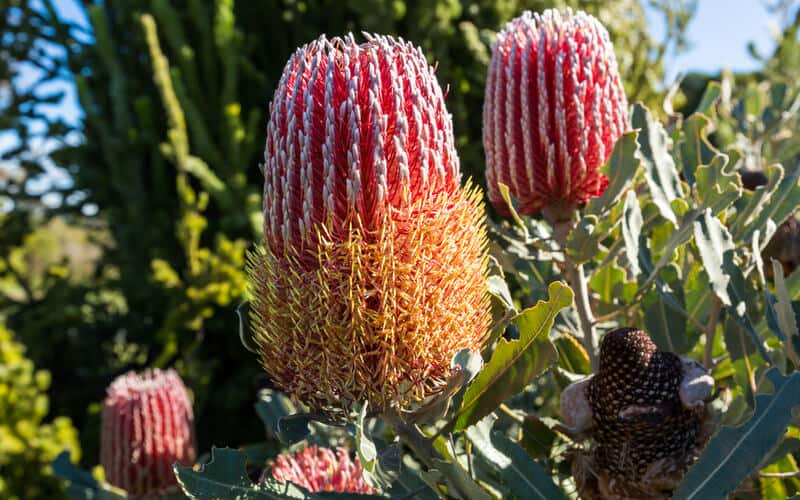
Size: Up to 25m (as trees)
Native range: All around Australia but most in WA
Conditions: Warm and Mediterranean climates, well-draining soil, plenty of sun
There are over 170 species of banksia trees in Australia, with most of them in WA. You’ve probably seen one around — look for a tree with serrated leaves and chunky, candle-like flowers.
Several varieties like Coast Banksia are fast-growing, usually adding at least 0.3m per year. The shrubs grow faster than the trees, often reaching full size in a few years.
Many banksias flower from autumn to winter, and you’ll get all sorts of colours, from red to yellow to greenish-white. The flowers have a sweet nectar that attracts birds and beneficial insects.
Banksias prefer sandy, well-drained soils that are slightly acidic. They love the sun and are drought-tolerant when mature.
NOTE: Banksia trees are very long-lived, often sticking around for several decades. If you want one in your garden, know that it’ll be there for a while!
Grevillea
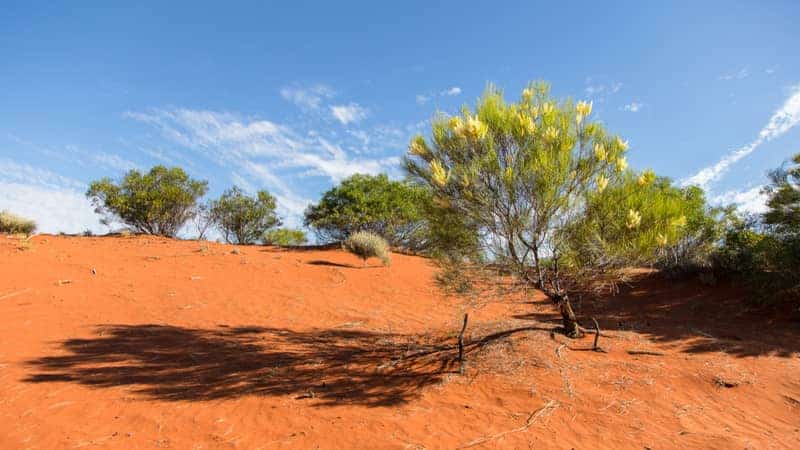
Size: Up to 10m (as trees)
Native range: All around Australia
Conditions: Climate depends on species, slightly acidic soil, plenty of sun
You’ll get many, many grevilleas around Australia, from low-growing ground cover to ornamental trees. One of the tallest is Grevillea robusta ‘Silky Oak’, which can reach 30m in the wild!
(Don’t worry, though — it usually only reaches 10m in cultivation.)
Grevilleas are known for their vivid, spiky flowers that come in all colours of the rainbow. They typically bloom from winter to spring.
As native plants, grevilleas have adapted to slightly acidic soils with poor nutrition. They prefer plenty of sunlight to get the most out of their blooms.
Wattle

Size: Up to 10m (on average)
Native range: All around Australia
Conditions: Climate depends on species, slightly acidic soil, sunny spots
Possibly one of the most iconic native trees down under is the sunshiney yellow wattle (Acacia)!
There are almost 1000 Australian wattle varieties, including the golden wattle — the country’s national floral emblem. They can be found everywhere, from city sidewalks to national parks.
These beautiful trees are fast-growing, often adding 0.5–1.0m of growth per year. However, they’re also short-lived, with a typical lifespan of 7–12 years.
If you want to grow wattles but don’t have much space, look for dwarf and shrub cultivars! These native trees are suitable for pots. Make sure to choose the correct pot size with good drainage.
Australian Native Flowering Trees
From WA to TAS, this country enjoys hundreds of native flowering plants. And they come in all sizes — from the chunky pig face, to the cheerful billy buttons, to these stunning trees!
Crepe myrtle

Size: Up to 15m
Native range: Primarily northeastern QLD
Conditions: Dry climates, well-draining soils, lots of sunlight
There’s one crepe myrtle tree native to Australia — Lagerstroemia archeriana, or the Queensland crepe myrtle. During summertime, these native crepe myrtles are stunners, bursting with pinkish-red blooms.
Queensland crepe myrtles are deciduous Aussie trees, so they’re also showy in autumn. The foliage turns orange and red before dropping in the winter.
Even bare, though, the trees are still attractive! Crepe myrtle branches naturally have a sinewy growth habit and mottled appearance, so your tree looks good year-round.
Native crepe myrtles are endemic to monsoon forests, so they thrive in dry climates. They tolerate poor soils so long as there’s good drainage.
Dwarf apple gum
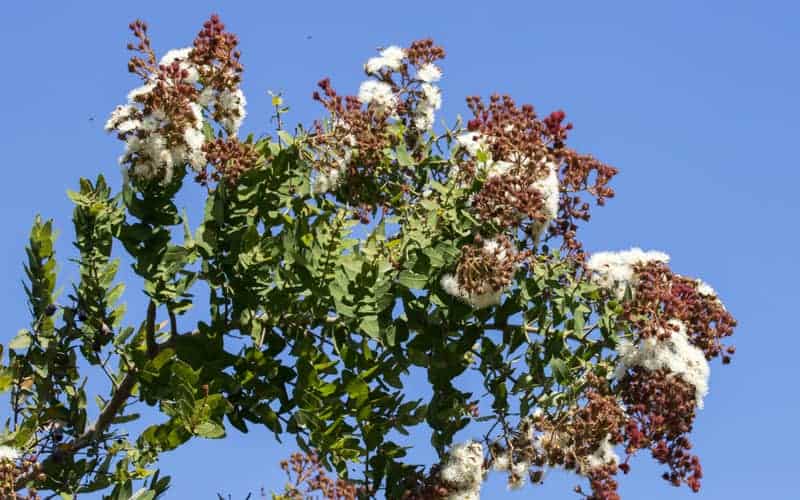
Size: Up to 8m
Native range: NSW
Conditions: Subtropical and temperate climates, slightly acidic soil, full sun
You won’t find many dwarf apple gum trees (Angophora hispida) in the wild, since they’re endemic only to a tiny area in New South Wales.
If you’re lucky enough to see or own one, though, these eucalyptus cousins have a unique charm. The young stems have little red “hairs”, while the mature trunk has flaky greyish-brown bark.
In summer, dwarf apple gum trees produce clusters of fluffy cream-coloured flowers, which butterflies and bees love. These eventually give way to small fruits that become a food source for many animals. (But not you!)
Dwarf apple gum trees grow in dry sandstone in their native range. They prefer poor, sandy soils with plenty of drainage, and lots of sunlight.
Hakea
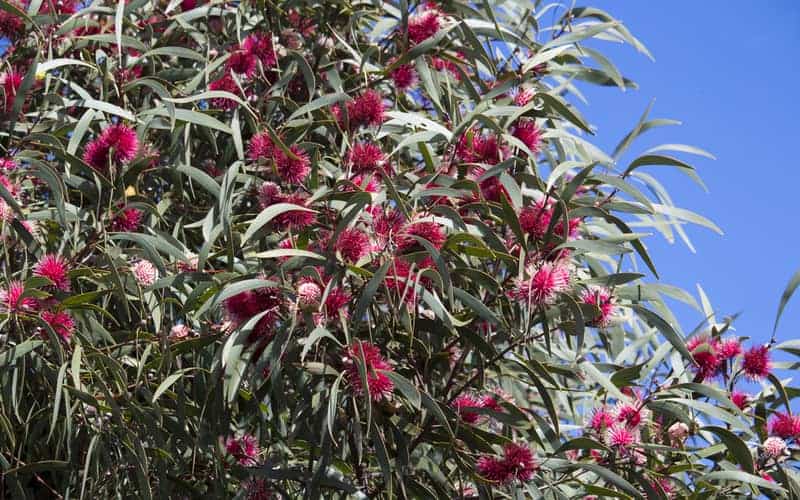
Size: Up to 9m (as trees)
Native range: All around Australia
Conditions: Climate depends on species, well-draining soil, full sun
There are more than 100 species of Hakea, from the beloved Pincushion Hakea to the fragrant Pink Lace Hakea. All of them are native to Australia!
(Fun fact: WA has the highest diversity of hakea species in the country.)
They’re best known for their flowers in winter and spring, which look like colourful balls with little “spikes.” The pom-pom flowers and pointy leaves give hakeas their nickname “needle bush.”
Hakeas do best in light, free-draining soils and plenty of sunlight. They’re shallow-rooted, so they can be planted near structures or along walkways.
NOTE: Some hakeas have become invasive outside their native range. Check your local council or state regulations regarding weed species, especially if you live in SA or VIC!
Australian Native Fruit Trees
There are plenty of native fruit trees in the country, and many have long been diet staples for Indigenous Australians.
These trees also provide food for local birds, bees, and butterflies — plus local wildlife who eat the fallen fruit.
Davidson’s plum
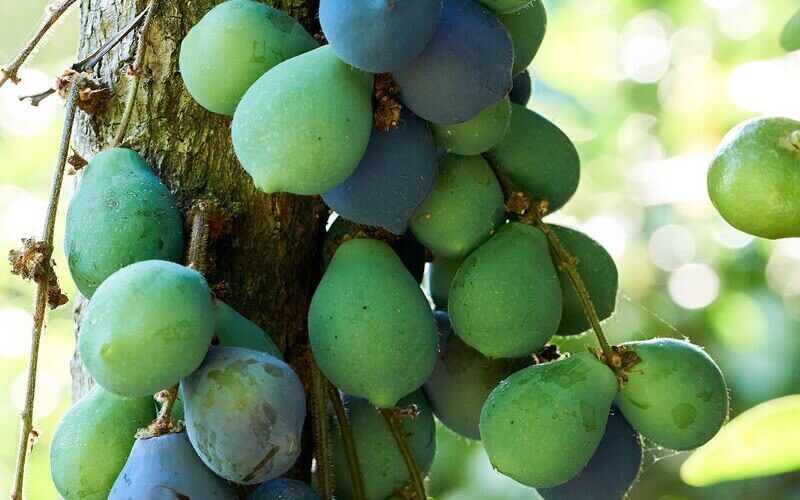
Size: Up to 12m
Native range: NSW and QLD
Conditions: Warm climates, well-drained soil, full sun to partial shade
Davidson’s plum (Davidsonia) is a popular bush tucker plant that has a long history with Indigenous Australians.
The tree has red-brown flowers in late spring, followed by blue-black fruits beginning the tree’s third season. The D. jerseyana variety bears fruit in summer, while D. pruriens (Ooray) typically bears fruit in winter.
Davidson’s plum fruits taste quite sour, so they usually aren’t eaten fresh — instead, they’re made into jams, stews, and preserves. Make sure to include the skin since it has plenty of nutrients!
Davidson’s plum trees grow best in warmer climates and moist conditions, since they’re endemic to the rainforest. Like most native plants, they prefer slightly acidic soil and plenty of sun.
Illawarra Plum
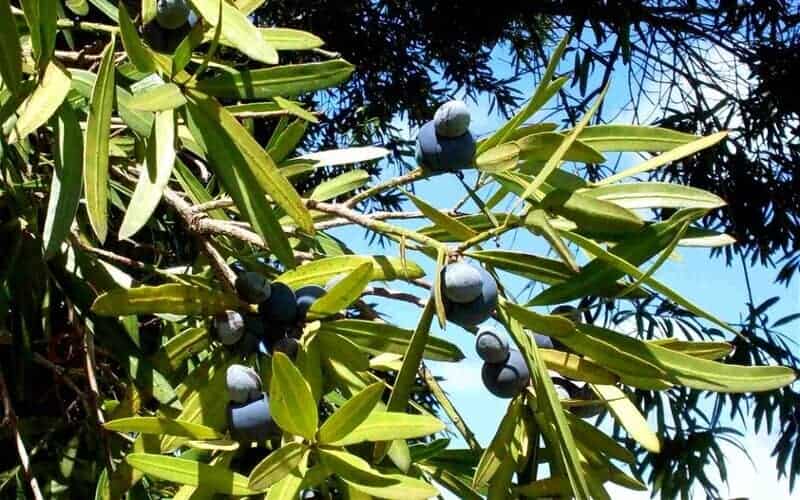
Size: Up to 15m
Native range: Along the east coast, primarily NSW
Conditions: Subtropical and coastal climates, slightly acidic soil, full sun to part shade
The Illawarra Plum (Podocarpus elatus) is a large, evergreen tree — but it’s actually a conifer (pine), not a plum! They do not produce cones, though; instead, they have single seeds on modified stalks.
These plum pines have round, bluish-purple fruits that ripen from autumn to early winter. They have a milder taste than regular plums and can be eaten fresh or made into jams and compotes.
Illawarra Plums are hardy trees that can tolerate a wide range of conditions. They prefer subtropical or coastal climates, but can grow in cooler conditions if protected from frost.
NOTE: Illawarra Plums need both a male and female tree to produce fruit!
Native Mulberry
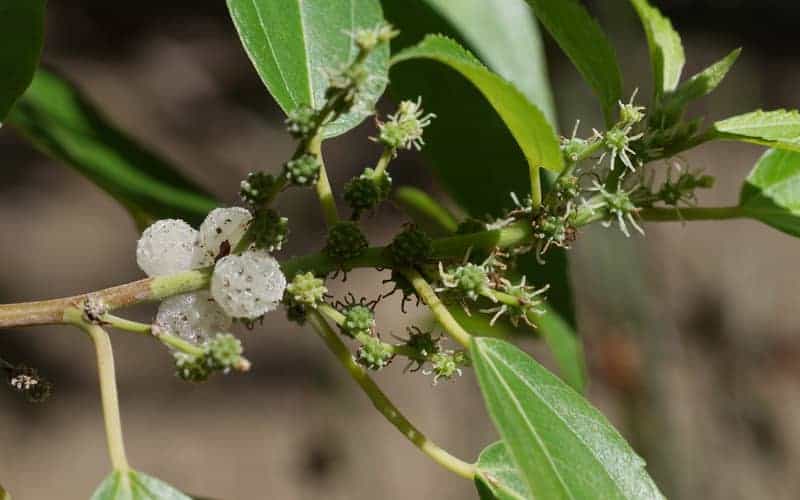
Size: Up to 8m
Native range: Northern and eastern rainforests, primarily QLD
Conditions: Subtropical climates, moist soil, full sun
Don’t be scared to pick these fruits — this tree is a non-stinging nettle! Native Mulberry (Pipturus argenteus) has sweet, juicy fruits that ripen between May and July.
(Just be warned, you’ll have plenty of competition from the local animals because the fruits are so tasty.)
This rainforest tree is valuable beyond the fruits. Indigenous Australians have used the roots and sap for traditional medicine, while the bark fibres are used for ropes and strings.
Native Mulberry trees thrive in warmer climates and do not do well in frost. They’re not as drought-tolerant as other native plants, since they prefer moist conditions with good drainage.
Large Australian Native Trees
In the wild, these trees can reach dozens of metres in height, towering over the ground. While they won’t be as tall in cultivation, they’re still not for a small garden!
Gum trees
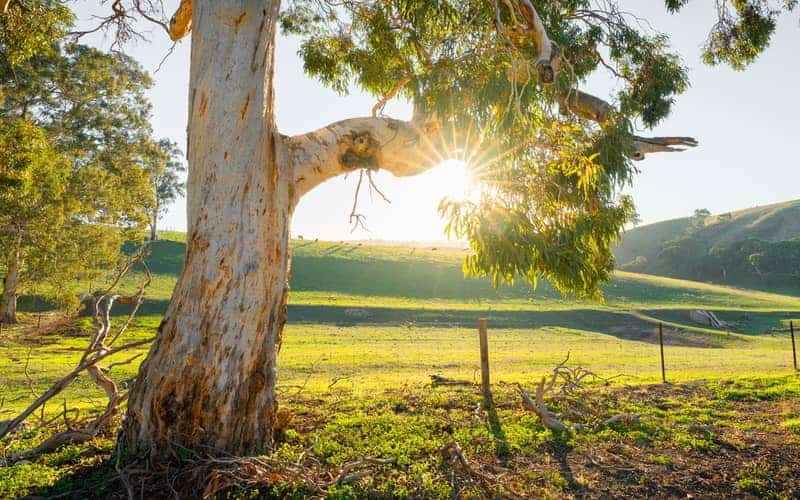
Size: Up to 100m in the wild
Native range: All around the country
Conditions: Climate depends on species, slightly acidic soil, sunlight to part shade
Gum trees (or eucalypts) are among the most iconic symbols of Australia. There are over 800 species of eucalypts, making them the third-largest tree genus in the world!
Eucalyptus, Corymbia, and Angophora trees (among others) all fall under the common name of “gum tree.” The name comes from the thick sap, which has many uses, from medication to food.
Other parts — bark, leaves, and flowers — are also versatile and useful. The leaves are used to produce eucalyptus oils, while the bark of many gum trees is great for timber.
And of course, gum trees are the source of gumnuts!
With such a wide variety, you’ll find gum trees that are just 2m (Plunkett mallee) to those that tower at almost 100m (swamp gum). If you want a eucalypt for your garden, check out the Silver Princess Eucalyptus.
Illawarra flame tree
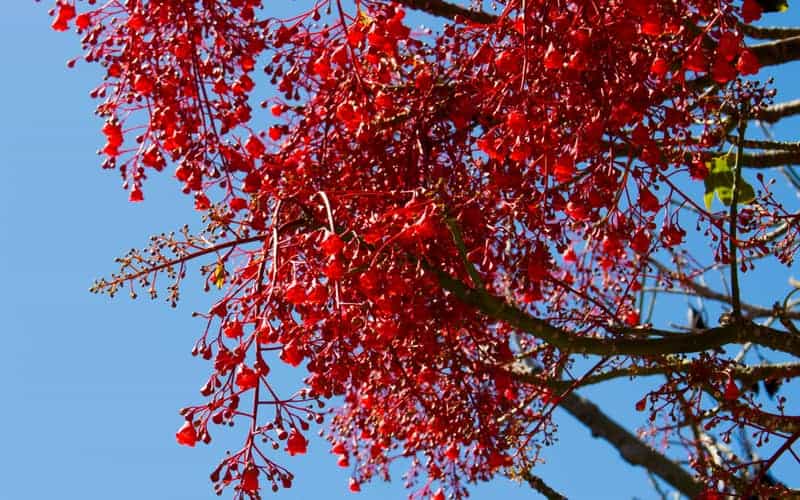
Size: Up to 35m in the wild
Native range: Coastal rainforests in NSW and QLD
Conditions: Subtropical and temperate climates, free-draining soil, lots of sunlight
What a display the Illawarra flame tree puts on in summer! This unique Aussie native loses its leaves before it blooms, allowing those fiery flowers to make one heck of an impression.
Brachychiton acerifolius, also called kurrajong, is one of the country’s few native deciduous trees. Besides the blooms, Illawarra flame trees are known for their edible seeds and roots.
Kurrajong is finicky about its flowering, though. It can take up to 8 years before a tree starts blooming, and even then, it usually needs a hot and dry summer to put on a show.
Wollemi pine
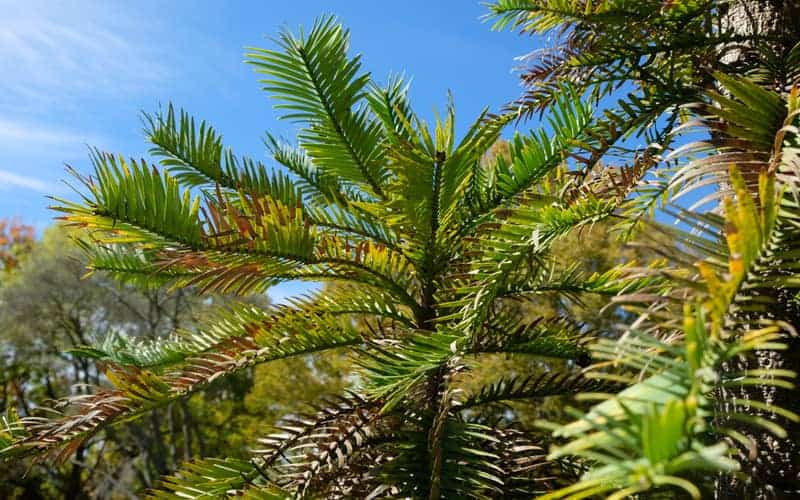
Size: Up to 42m in the wild
Native range: Wollemi National Park (NSW)
Conditions: Temperate climate, loamy soil, light shade
Say hello to one of the oldest, rarest plants in the world — the Wollemi Pine (Wollemia nobilis).
There are less than 100 of these historic trees growing in a small pocket of Wollemi National Park. The species dates back 91 million (yes, million!) years and was thought to be extinct until 1994.
Starting in 2005, the pine was made available to home gardeners in Australia. In return, conservationists learned valuable information about the Wollemi Pine’s growing conditions to help conservation efforts.
Wollemi Pines prefer loamy soil and temperate climates with above-average rainfall. They grow best in temps between 3.2ºC and 25.4ºC but can tolerate cold down to -10ºC and heat up to 35ºC.
Australian Native Trees for Privacy
One way to create natural privacy screens in your garden is by planting native shrubs or trees! The dense, evergreen foliage of these plants will help keep you out of sight.
Bottlebrush
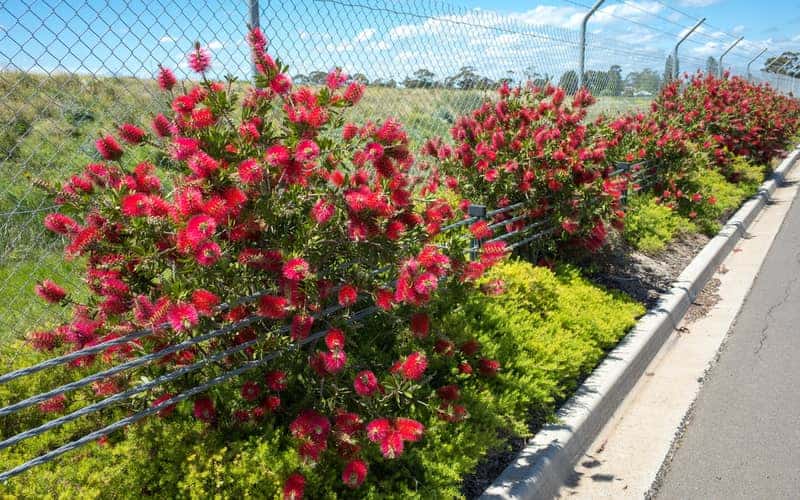
Size: Up to 4m (as shrubs) or 5m (as trees)
Native range: Primarily east and southeast Australia
Conditions: Tropical to temperate climates, damp soils, lots of sunlight
One look at the bottlebrush (Callistemon) and you’ll know exactly where it got its name. The vivid flowers look just like the tip of a bottle brush!
Callistemons are fast-growing, hardy trees found along swamps or waterways in the wild. They prefer damp conditions since they’re endemic to high-rainfall regions.
The trees have a dense growth habit and evergreen foliage, so they’re perfect for screening or privacy. Some varieties are compact enough to require minimal pruning.
If you live in a dry climate, look for varieties like Callistemon Better John™ or Prickly Bottlebrush, which tolerate drought better than others.
Lilly Pilly
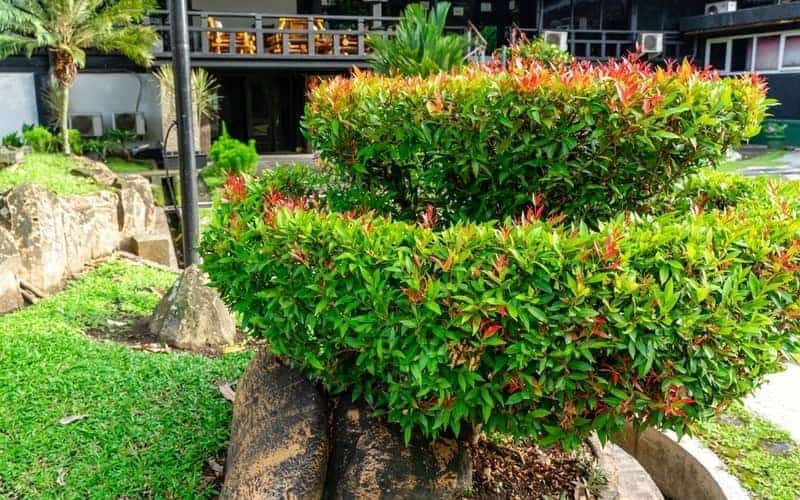
Size: Up to 5m (as shrubs) or 15m (as trees)
Native range: Primarily along the east coast
Conditions: Most climates except cold or arid, rich soils, lots of sunlight
Most Lilly Pilly varieties come from the Syzygium genus, but nurseries and garden centres also use the name for Acmena and Waterhousea plants.
Whether as a shrub or tree, the Lilly Pilly has dense, evergreen foliage — making it perfect as a privacy or screening plant. The canopy also provides shelter from the wind.
Syzygium plants grow quickly, adding up to 0.6m of height a year depending on the variety. Regular pruning maintains a good shape and encourages lush foliage.
Besides providing privacy, the Lilly Pilly also produces edible berries! The fruits are tart and often used to make jams and pastries.
Native frangipani
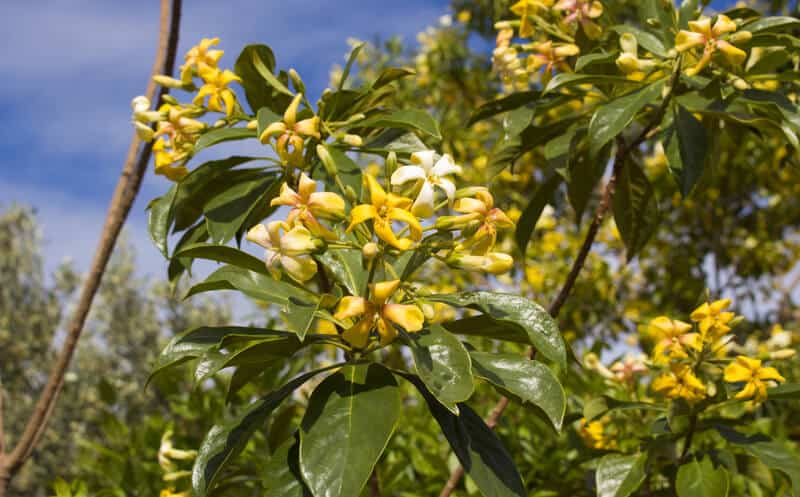
Size: Up to 12m
Native range: Primarily NSW and QLD
Conditions: Subtropical to warm temperate climates, rich soils, lots of sunlight
No, this isn’t the exotic Plumeria plant. The native frangipani (Hymenosporum flavum) is a different plant, even if the two share a name.
Aussie native frangipanis have a compact growth habit and dense, glossy leaves. They’re great as privacy or screening trees, especially since they’re evergreen!
From mid-spring to early summer, these trees put out cream flowers that turn yellow over time. They’re very fragrant and attract lots of birds and insects.
Be mindful of the brown fruit capsules, though — they are inedible and may cause adverse reactions in pets.
Australian Native Shade Trees
“Slip, Slop, Slap” should tell you everything about how bright and sunny it gets down under. These native canopy trees provide the perfect relief from intense sunlight.
Brush box
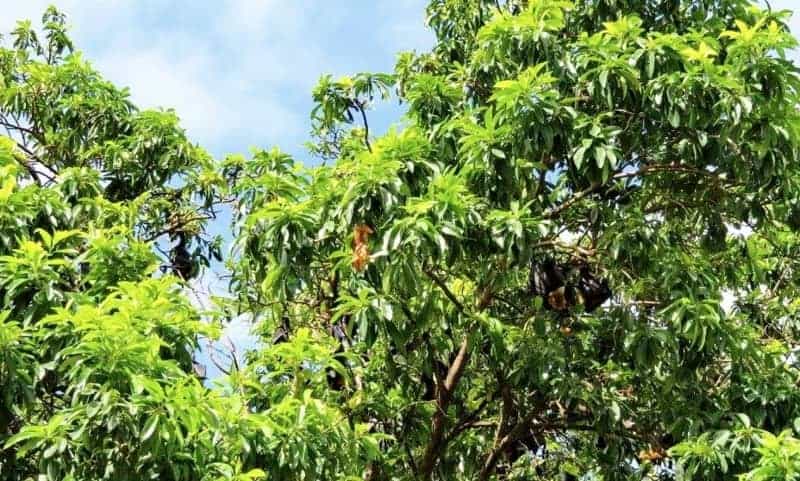
Size: Up to 15m in cultivation
Native range: Primarily NSW and QLD
Conditions: Subtropical to temperate climates, acidic soils, lots of sunlight
The Queensland brush box (Lophostomen confertus) looks like a cartoon tree with its dark green leaves and rounded shape.
The wide canopy (up to 10m) and dense foliage make it the perfect shade tree. Additionally, brush box has a minimal risk of falling limbs or branches, so it’ll do fine in your backyard.
Queensland brush box grows best in rich, loamy soils, but it can survive in most conditions. It’s commonly used as a street tree in many cities due to its high tolerance for pollution and drought.
Ivory Curl
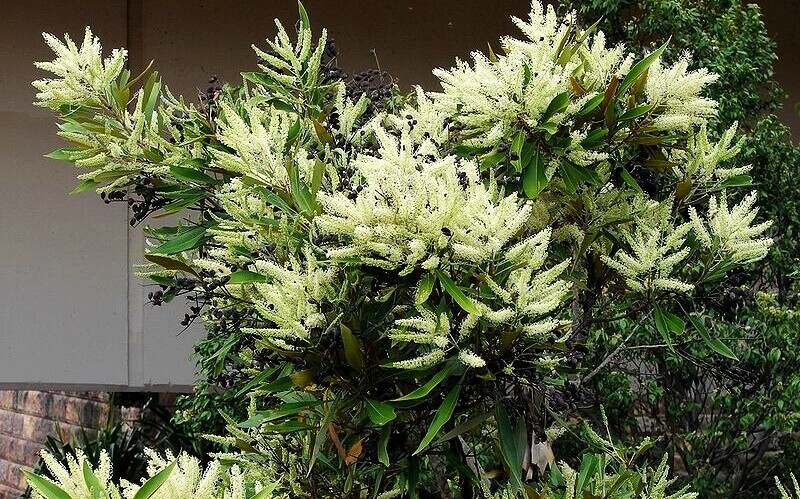
Size: Up to 15m in cultivation
Native range: Northeastern QLD
Conditions: Subtropical and warm climates, slightly acidic soil, full sun
If there’s any tree that makes a statement in autumn, it’s the Ivory Curl (Buckinghamia celsissima).
These trees can reach an immense 30m in the wild, but the garden varieties are much smaller. Still, even small cultivars are show-stopping, thanks to the curly, ivory-coloured flower spikes.
B. celsissima is evergreen, so the trees keep their dark green leaves when the flowering season is over. That dense foliage and spreading crown make Ivory Curl a great shade tree.
Like most native plants, Ivory Curl prefers slightly acidic soil. It’s fairly drought-tolerant when mature, but may not do well if allowed to completely dry out.
Willow myrtle
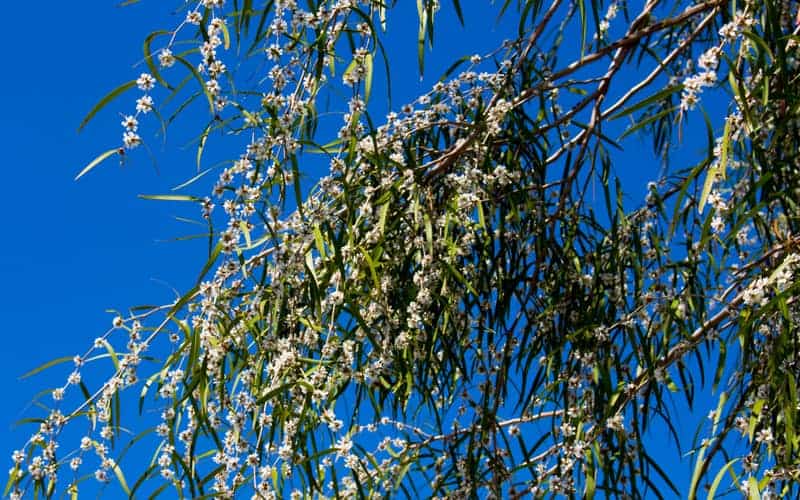
Size: Up to 15m
Native range: Southwest coasts of WA
Conditions: Most climates, moist but well-draining soil, full sun
A delicious minty scent paired with a romantic weeping habit — what more could you want from the native willow myrtle?
There are 4 species of Agonis trees endemic to southwestern WA, but the most commonly cultivated is Agonis flexuosa. Its graceful, weeping branches form a wide canopy that provides the perfect shade.
Willow myrtle leaves start a ruddy red before turning green over time. When crushed, the narrow leaves smell like peppermint!
A. flexuosa is adaptable to many climates, so long as it has moist, free-draining soils. It can tolerate drought, winds, and hard pruning.
Small Australian Native Trees
Don’t have much garden space? Or maybe your yard is getting a bit crowded? These small native trees will fit right in — they’re all less than 10m.
Lemon myrtle

Size: Up to 8m in cultivation
Native range: Central and southeastern QLD
Conditions: Subtropical climates, well-drained soil, sun to part shade
If you’re a fan of citrus, you’ll love the native lemon myrtle (Backhousia citriodora). This isn’t a fruit tree, though — it’s the leaves that are valuable in cuisine and medicine!
When crushed, lemon myrtle leaves release an intense citrus scent and flavour. That makes B. citriodora a popular native herb used in teas, syrups, pastries, and even ice creams.
Lemon myrtle typically grows to 8m in ideal conditions, but this native tree is also suitable for pots. Besides the foliage, the plant is popular for its fluffy flowers and elegant branches.
As rainforest plants, lemon myrtles grow best in warm, sunny spots and rich soils. They grow slowly but are very hardy and low-maintenance.
Tuckeroo
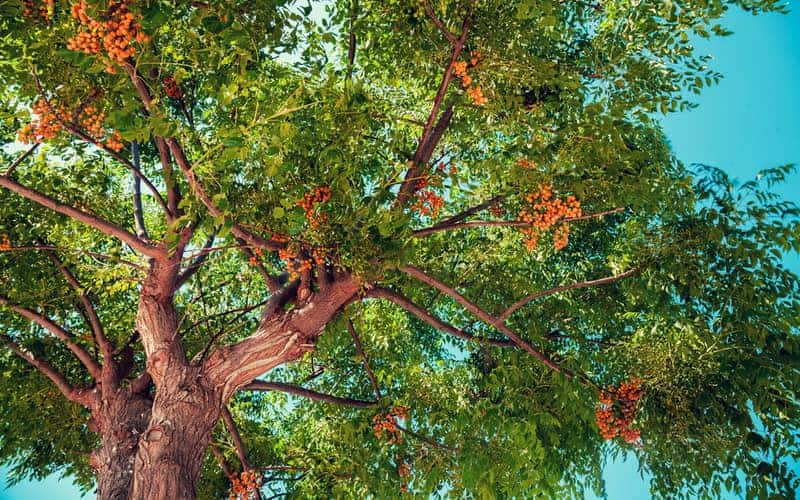
Size: Up to 9m
Native range: Northern WA, and areas of NSW, NT, and QLD
Conditions: Subtropical and temperate climates, free-draining soil, full sun to light shade
Tuckeroo (Cupaniopsis anacardioides) has faintly sweet flowers and a beautiful canopy. You may also know the plant as carrotwood, cashew-leaf cupania, or beach tamarind.
The tree grows 5–9m tall, but it can grow fairly wide — around 5–7m. While the roots aren’t considered “invasive,” they can be quite strong, so keep the tree a short distance from sidewalks and pathways.
Tuckeroo’s evergreen foliage looks bronze-ish when the tree is young, and cream flowers emerge from autumn to winter. In early spring, you’ll get small, orange fruits that are favourites among birds.
The seeds are sharp, so watch your step after the fruits fall!
Waratah
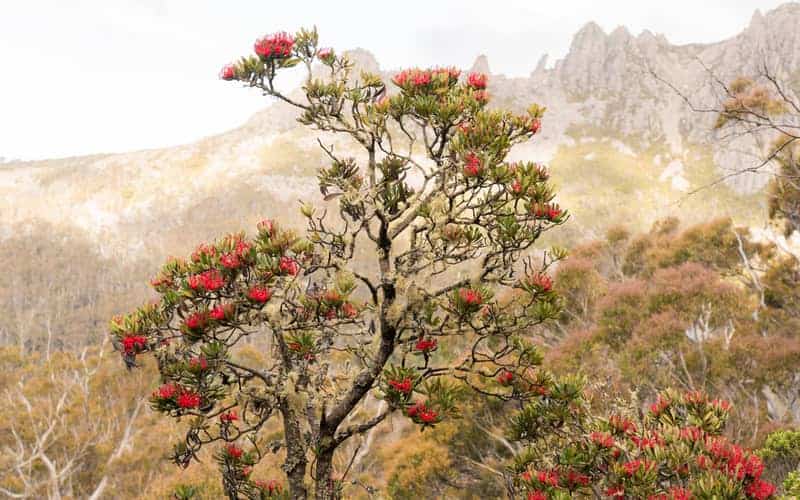
Size: Up to 4m in cultivation
Native range: Primarily NSW, also VIC and TAS
Conditions: Temperate and subtropical climates, acidic soil, semi-shade
You’ll recognise a waratah (Telopea) instantly, especially the NSW waratah and its large, cherry-red flowers.
The NSW waratah (Telopea speciosissima) is the most well-known, but there are 4 other native species and many hybrids. If you’re lucky, you’ll come across the rare white cultivar, Wirrimbirra White!
Waratahs don’t take up much space — they typically reach 4m in cultivation. They’re also not aggressive spreaders, making them a good choice for small Australian native trees with non-invasive roots.
The waratah does best in dappled or light shade, as harsh sunlight can scorch the flowers. Plant waratahs with plenty of space around them to ensure good air circulation.
FAQs — More to Know About Native Australian Trees
Here are a few more fun things to know about Aussie trees.
What is the most common native tree in Australia?
Eucalypts, or gum trees, are the most common trees in Australia! It’s estimated that eucalypts make up 75% of Australia’s native forest area.
The next most common would be wattles, with over 1000 endemic species of acacia.
What is the fastest-growing Australian native tree?
Eucalypts are also among the fastest-growing Australian native trees. Some eucalypts, such as Sydney blue gum, can add 0.9m or more of growth in a year.
What are Australia’s national trees?
The golden wattle (Acacia pycnantha) is Australia’s national tree and floral emblem.
Individual states and territories also have their own floral emblems.

